Kansas has a lot more diverse environments within than you might think. Sand dunes, canyons, valleys, as well as mountains and plains. You can find all these and more in the Sunflower State. Today we are going to talk about the birds of Kansas and as you can guess, there are quite a lot of them. We hope today to give you a little taste of what the birding life is like in Kansas and give you a few birds to be on the lookout for. We’ll also throw in some hotspots to visit and some feeder tips, so without further ado let’s get started and talk about the popular backyard birds of Kansas!
3 Categories – 453 Birds
Kansas is home to approximately 453 species of birds and the Audobon rates them as 3rd place in the nation when it comes to diversity of Avian species. Of course we can’t list all of the birds here but we can at least get you started. To make things easier we are going to list some birds to look for and divide them up like this:
- Year-round Resident birds
- Birds of Spring, Summer, and Early Fall
- Fall and Winter Birds
We’ll let you know what to look for when identifying these birds and throw in some tips on what they like to eat as well as where they like to hide when they aren’t scoping out or feasting at the feeders in your backyard. We’ll begin with the long-term resident birds of the Sunflower State.
Kansas’s Year-round Resident birds
The birds we have in this category have made Kansas their full-time home and may be spotted at any time of the year. So the next time that you break out those binoculars see if you can spot one of these following year-round resident birds:
- American Goldfinch
- Dark-eyed Junco
- American Robin
- Tufted Titmouse
- Mourning Dove
American Goldfinch – Spinus tristis

Coloration and Markings: The male American Goldfinch is handsome and easy to identify. They have a bright yellow back with long, black wings which carry 2 white wingbars as well as some vertical white lines lower and more central on the folded wings. They have long, thin black tails with heavy white markings and some white on the undersides coming from a white rump. The breast and underbelly of this bird is bright yellow, like it’s back, and facially you’ll see the same yellow and it is uninterrupted with the exception of a small black cap from the mid=top of the head going down to the stout, pink, conical bill. Females will display a more muted yellow on the lower parts of the body and tend towards olive coloration on top. In the winter, these birds shed the bright in lieu of the brown bodies with black wings, changing into much drabbier attire though you can still see their wingbars if you look closely.
Size: These birds measure in at 4.3 – 5.1 inches in length with wingspans of 7.5 to 8.7 inches.
Habitat: These birds love to spend time foraging in overgrown fields, especially those prone to flooding. You can also see them quite often at travel stops, parks, home gardens, and in backyards looking for their next meals.
Diet: Make a mix of Nyjer thistle and Black Oil Sunflower seeds and you might just get the attentions of these lovely yellow characters.
Dark-eyed Junco – Junco hyemalis

Coloration and Markings: While there are a lot of regional variations in color, the most common variety of the Dark-eyed Junco is going to be dark gray or brown on the top 2/3 of the body and light colored below. They have dark gray or brown backs and long, gray or brown wings as well as long, gray tails with white undersides. They have a white rump as well as a white breast and underbelly, however, beginning at the underbelly there is a flanking of gray at the sides which widens greatly as it approaches the breast. Facially, this bird has a gray or dark brown face with a medium-length, stout pink bill.
Size: These birds measure 5.5 – 6.3 inches from tip to tail and have wingspans of 7.1 to 9.8 inches.
Habitat: These birds range less when it is warm, prefer to spend time in coniferous or mixed coniferous woods. They start ranging the most in winter, when you can spot them in parks, fields, and backyards.
Diet: Try a combination of Sunflower hearts, White Proso millet, and cracked corn for attracting the lovely Dark-eyed Junco into visiting your backyard feeder.
American Robin – Turdus migratorius
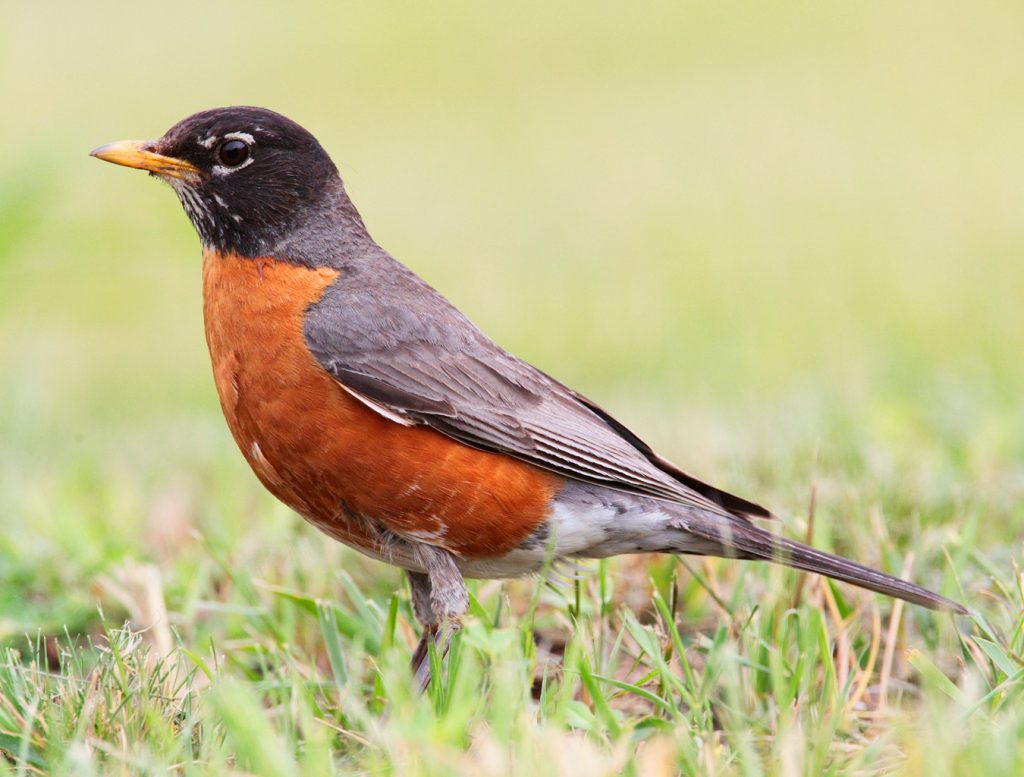
Coloration and Markings: American Robins are grayish-brown birds with long wings and long, dark gray to black tails which are white on the undersides. Their rump is white but the underbelly and breast are orange red or simply a lovely apricot orange color. Facially, these birds have black heads with a fragmented white eyering surrounding the eyes and a minute tuft of white present just underneath a medium-length, curved yellow bill.
Size: These birds measure in at 7.9 – 11 inches in length with wingspans of 12.2 to 15.8 inches.
Habitat: These birds love deciduous woods but they are equally at home in fields, gardens, and backyards.
Diet: While Robins will eat insects and even small snakes in the wild, they also have a sweet tooth. Try luring them in with some chopped Apples, Blueberries, and Raisins. These birds love them!
Tufted Titmouse – Baeolophus bicolor
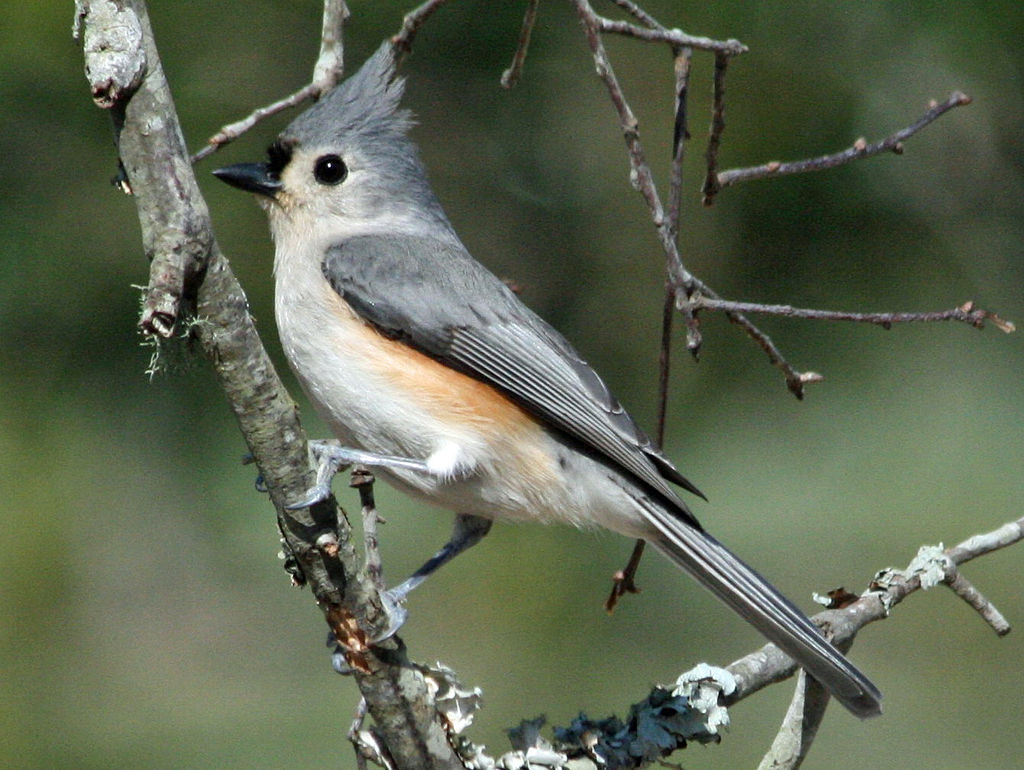
Coloration and Markings: The Tufted Titmouse has a gray to blue gray back, with medium-length blue-gray wings and long blue and gray tails. The breast and underbelly of this bird are white but when it is close you will notice a peach color lightly present just under the wings. Facially, this bird has a mostly white face, with the exception of a cute blue crest where some blue curls down to lightly frame the eyes from behind and a distinctive black spot above the bill. This bill is short, straight, and black and you will notice some slight curvature present on the upper bill.
Size: These birds measure in at 5.5 – 6.3 inches in length with a wingspan of 7.9 to 10.2 inches in width.
Habitat: These birds are typically found at elevations of 2000 and below, favoring Evergreen and deciduous woods when they are spending time in the wild. They do range quite often, however, and are frequent visitors to parks and backyards.
Diet: Suet, peanuts, and Black Oil Sunflower seeds are all favorites of the Tufted Titmouse.
Mourning Dove – Zenaida macroura
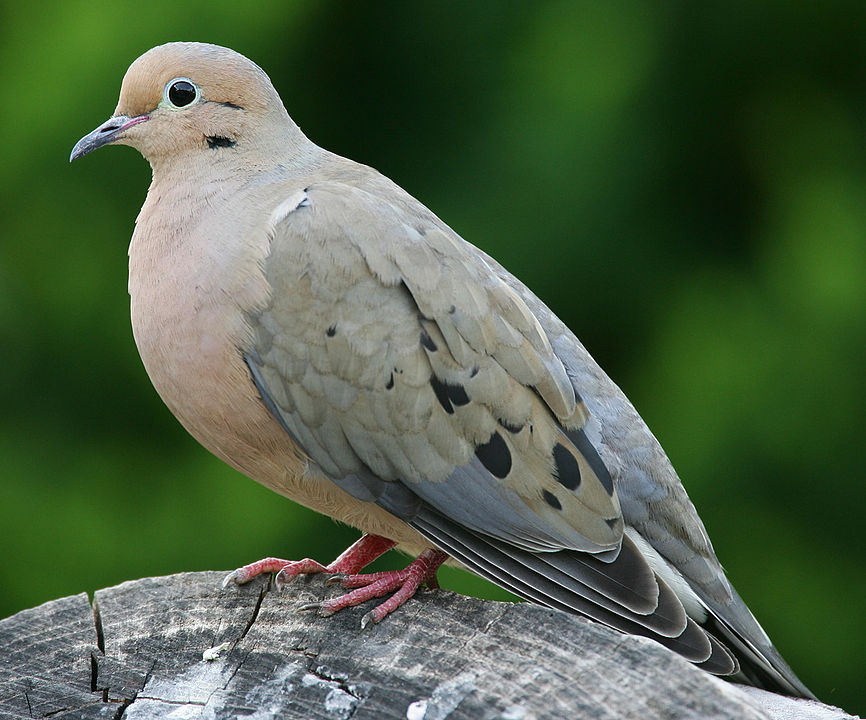
Coloration and Markings: Mourning Doves have a simple, yet lovely coloration that makes them quite easy to identify. They are typically light brown or gray with a lot of buffy-tan coloration present. They have gray backs and wings, with a heavy concentration of tan on the wings as well as some distinct, large black spots present towards the center of the wings. They have long, thin gray tails and their breast and underbelly will be heavy with a salmon-tan coloration mixed with white and flanked with pure white lightly underneath the wings. Facially you will see the deepest concentration of tan color as well as a thin, white eyering that gives the face an almost cartoonish look. These birds have medium-length, straight black bills.
Size: These birds measure in at 9.1 – 13.4 inches in length and have wingspans of approximately 17.7 inches.
Habitat: Mourning Doves have been around people for a long time and as a result they prefer farms and cities to the deep woods. Look for them on sidewalks or phone lines, scoping out snacks in the city.
Diet: These birds love weed-seeds but you can make due in your feeder by leaving out some White Proso millet, wheat, cracked corn, or even Black Oil Sunflower seeds. Mourning Doves will be quite happy with any or all of these items present.
Kansas’s Birds of Spring, Summer, and Early Fall
When the frogs start making their croaky music and the birds join in as the Crocus starts to bloom… well, it might just be springtime again in Kansas. During this season there are a lot of new Avian arrivals coming and many of them stick around for a good bit of time. See if you can spot one of these lovely birds during spring, summer, or the early fall:
- Indigo Bunting
- Baltimore Oriole
- Brown-headed Cowbird
- Yellow-billed Cuckoo
- Purple Martin
Indigo Bunting – Passerina cyanea

Coloration and Markings: Male Indigo Buntings will make you do a double-take. They are a rich Indigo blue on their backs, their medium length wings, and their long tails although sometimes you will see some gray highlights present. Their breast and underbelly are the same rich blue, which seems to deepen in color at the face. A tiny amount of black is often present just in front of the eyes and these birds have stout, medium-length conical silver bills. Females, by contrast, will be brown with streaking on the breast and lighter coloration at the throat. Some tints of blue may be present in the plumage but they will be minimal. Juvenile males will display a mix of blue and brown patches throughout their plumage.
Size: These stunning birds are quite tiny, measuring in at 4.7 – 5.1 inches from tip to tail and with wingspans of 7.5 to 8.7 inches in width.
Habitat: When Indigo Buntings are singing it will be from the highest perching places that they can find, otherwise look for them around brush, brambles, thickets, and thorns. These birds like a little cover when they are foraging and so dense vegetation increases their comfort levels in a new area.
Diet: For best results, add a combination of Nyjer thistle, fresh berries (Blackberry and Strawberry are good examples), and sprinkle some live or dried mealworms on top. These little birds will love you for it!
Baltimore Oriole – Icterus galbula
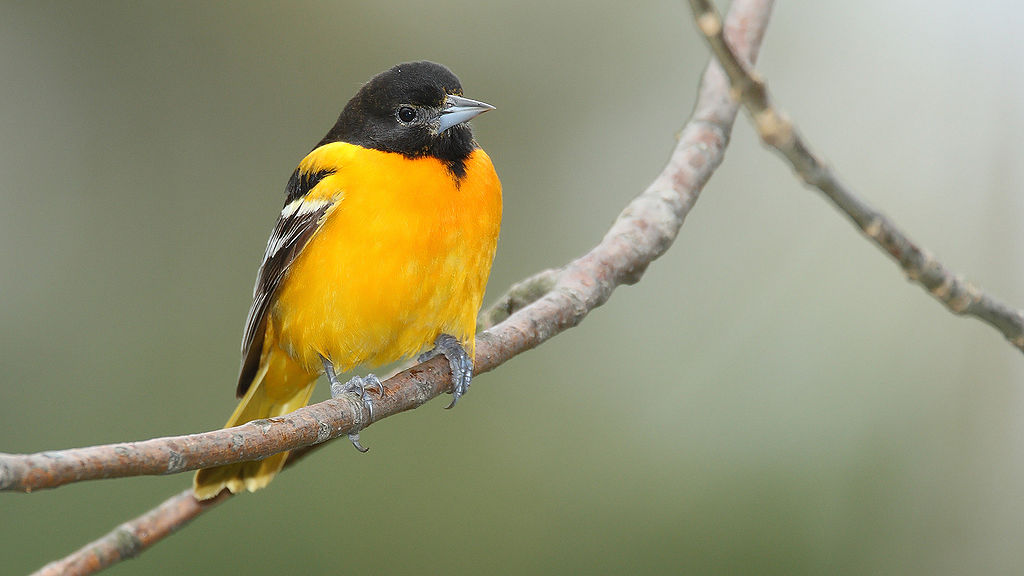
Coloration and Markings: Male Baltimore Orioles have black backs which become a flame-orange color towards the rump. They have long, black wings with a white wingbar on each wing and some white highlighting present as well. Their tails are short and black on top, but edged with orange which is also visible underneath the tailfeathers. They have a flame-orange rump, underbelly, and breast and this bird has a black face with a thin, white eyering present. This bird has a medium-length, stout, and sharp silver bill. Females and Juveniles tend to be gray, rather than black, and will display 2 wingbars on each wing and their orange will be more of a yellow-orange instead of ‘flame’.
Size: These birds measure in at 6.7 – 7.5 inches in length with wingspans of 9.1 to 11.8 inches.
Habitat: These birds love the lofty reaches of deciduous trees in open areas. Look for them at the forest’s edge, parks, and backyards (especially those with some tall trees!).
Diet: Halved-oranges and whole cherries are a great way to get and to keep the attentions of the Baltimore Oriole.
Brown-headed Cowbird – Molothrus ater

Coloration and Markings: Male Brown-headed Cowbirds rather look like Blackbirds with brown heads. They have shiny black backs, large black wings, and long, black tails, and a black underbelly and breast to go with them. Facially, these birds are brown throughout the face and all the way down to the base of the throat. These birds have stout, short, black bills. Females will be a much lighter brown and present brown and white streaking at the breast. The lighter coloration also makes their dark eyes much more noticeable on the female than on the male.
Size: Male Cowbirds measure in at 7.5 – 8.7 inches, with females ranging in length of 6.3 – 7.9 inches. They have wingspans between 14.2 – 15 inches in width.
Habitat: These birds love the forest’s edge as well as other open areas, such as fields, farms, parks, and the occasional backyard.
Diet: These birds love cracked corn, White Proso millet, peanuts, and Black Oil Sunflower seeds.
Yellow-billed Cuckoo – Coccyzus americanus

Coloration and Markings: Yellow-billed Cuckoos have light brown backs and long, brown wings with the color becoming almost a fox-brown towards the tips of the wings. They have long, gray tails with very distinct white spots on both sides of the tailfeathers. The underbelly and breast of this bird will be paper-white and this white continues up into the face, stretching horizontally to the edges of the cheeks and changing to brown coloration at the back of the neck and the portions of the face above the eyes. These birds have long, curved yellow bills with some black often present on the upper bill.
Size: These are good-sized birds, measuring in at 10.2 – 11.8 inches from head to tail and with wingspans of 15 to 16.9 inches in width.
Habitat: These birds prefer deciduous regions, preferably in open-areas such as meadows, clearings, or the forest’s edge.
Diet: You might have some luck with suet cakes or mealworms (preferably live) and this bird also likes small berries and fruits. Empty nests in the yard can sometimes make them curious enough to spy the feeder and from there it will be up to the bird.
Purple Martin – Progne subis
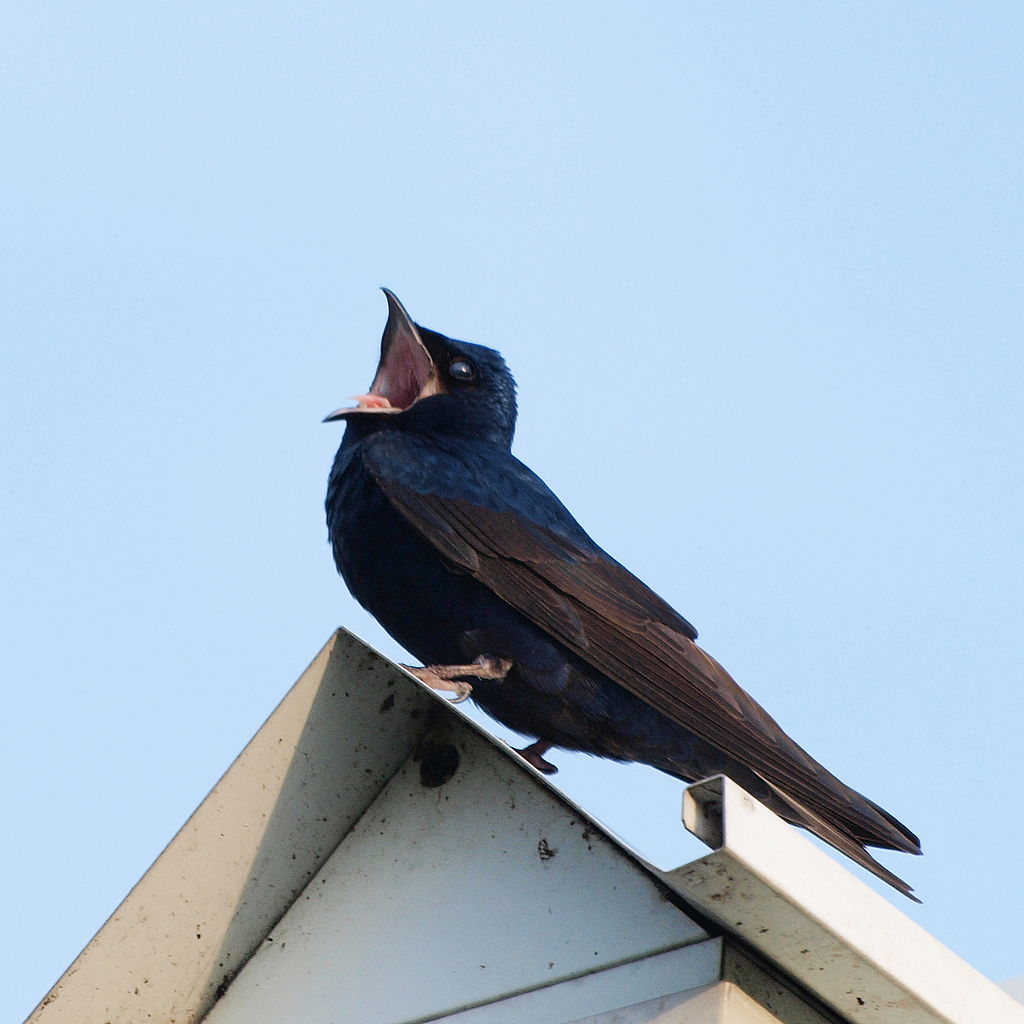
Coloration and Markings: Purple Martins have a beautiful plumage that will certainly get your attention. Their backs have a dark blue and purple ‘scale’ type pattern to them, and this extends to the shoulders of the bird’s long wings though the lower portions of the wings will be black and brown. They have short, forked tails which are also black and brown and the underbelly and breast of this bird will have the blue and purple scaling, which deepens in color as it moves up to the breast and throat. The face of this bird will be blue and purple scaled with a diamond-shaped black mask present in front of a small, slightly hooked black bill. Females and juveniles will have more muted colors and a much lighter colored breast and underbelly.
Size: These birds measure in at 7.5 – 7.9 inches in length with wingspans of 15.3 to 16.1 inches.
Habitat: These birds love open areas and tend to travel in numbers. They are quite receptive to nesting boxes if you are looking to add a little ‘bug control’ to your backyard. They can sometimes be spotted in the wild around the forest’s edge, especially if there is water nearby.
Diet: These birds are primarily insectivorous (which makes them great to have in the yard!) and you can sometimes tempt them with dried or live mealworms.
Kansas’s Fall and Winter Birds
Kansas has some chilly winters, with lows approaching around 15 degrees Fahrenheit. That doesn’t bother the birds in this category at all, however, and they can be seen foraging during this time in a number of location. Look for these Kansas winter birds and be sure to leave a little something out in your feeders. These guys can really use your support:
- Black-capped Chickadee
- Blue Jay
- House Finch
- Purple Finch
- Red-headed Woodpecker
Black-capped Chickadee – Poecile atricapillus
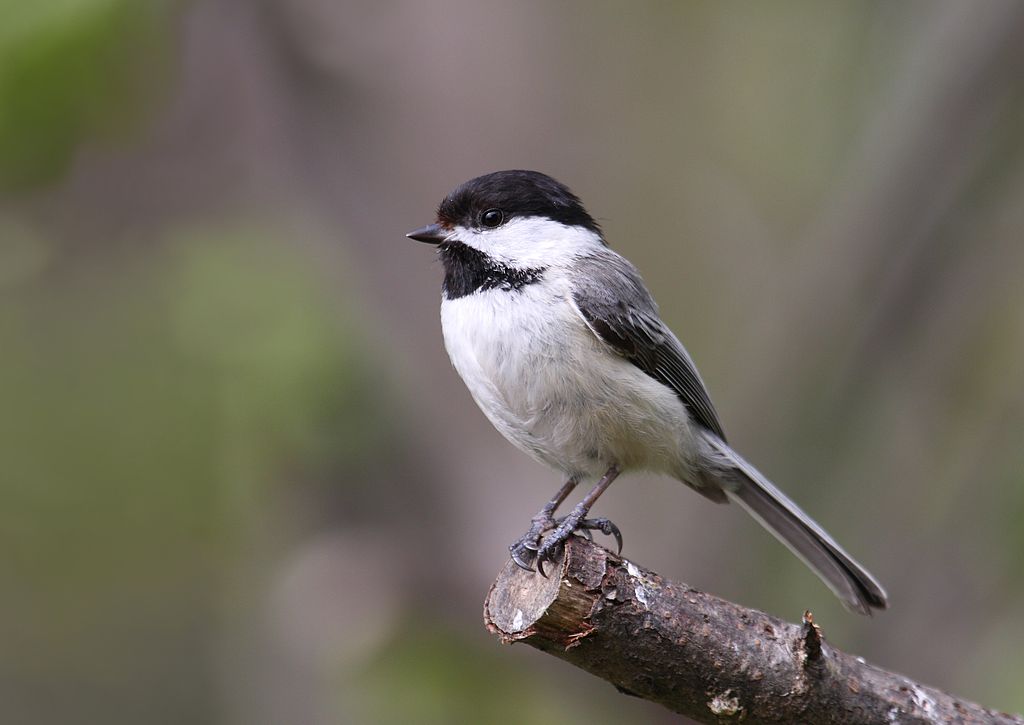
Coloration and Markings: Black-capped Chickadees have backs which are a soft, smooth gray and medium-length wings which are gray with some white edging. They have long, gray tails with white edges as well and the underbelly and breast of this bird are snowy white with some very delicate buff coloration flanking under the wings. Facially, these birds have white faces with small black bibs and large black caps which come down to terminate just under the eyes. These birds have tiny, cojnical black bills.
Size: These little Chickadees measure in at 4.7 – 5.9 inches in length and have wingspans of only 6.3 to 8.3 inches.
Habitat: If there is some dense vegetation and a few trees then this bird is quite comfortable. You can spot them in parks, overgrown fields, and even around marshes. They are happy to visit backyards and have a preference for Alder and Birch trees when it comes to nesting.
Diet: Mix up some suet and chunky peanut butter and you have a winning combination for getting the attention of the Black-capped Chickadee.
Blue Jay – Cyanocitta cristata
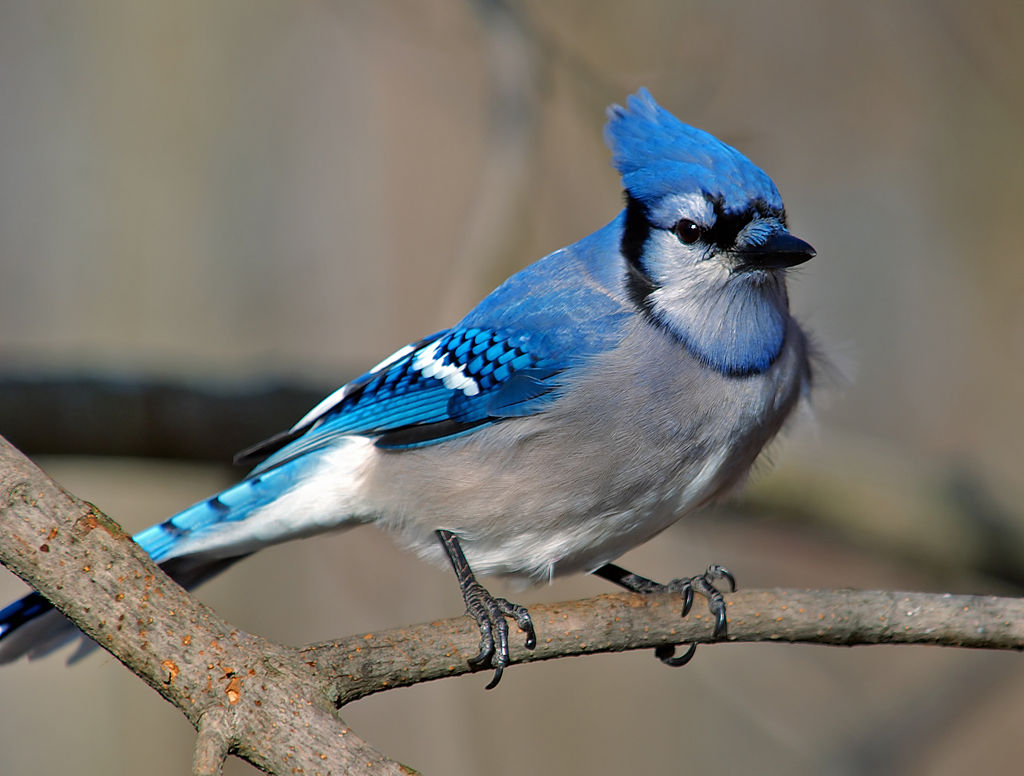
Coloration and Markings: Blue Jays are quite the lookers. They have soft blue backs and long wings which have blue ‘scales’ outlined in black as well as 1 white wingbar on each wing and some white spots outlined in black towards the wing’s centers. They have long, blue tails with lighter blue, symmetrical square patterns of 2 outlined in darker blue going down the tail and with white on their undersides. The breast and the underbelly of this bird are snow-white and this continues up into the face where it is the primary color with a few exceptions. Most noticeable is the brilliant blue crest of the Blue Jay and at the back of its head a black line that goes down and circles the base of the throat to the other side of the face. This bird also have a thin, rather chaotic mask reminiscent of Venetian leather masks for parties and it has a long, stout, and straight black bill.
Size: These birds measure in at 9.8 – 11.8 inches in length with wingspans of 13.4 to 16.9 inches.
Habitat: Blue Jays love the forest’s edge and are especially fond of Oak stands, where they can obtain acorns to smash open for the yummy goodness inside.
Diet: Blue Jays love peanuts, suet, and Black Oil Sunflower seeds, so be sure to leave one or more out for them just in case. No matter how many times you see a Blue Jay they always get your attention!
House Finch – Haemorhous mexicanus
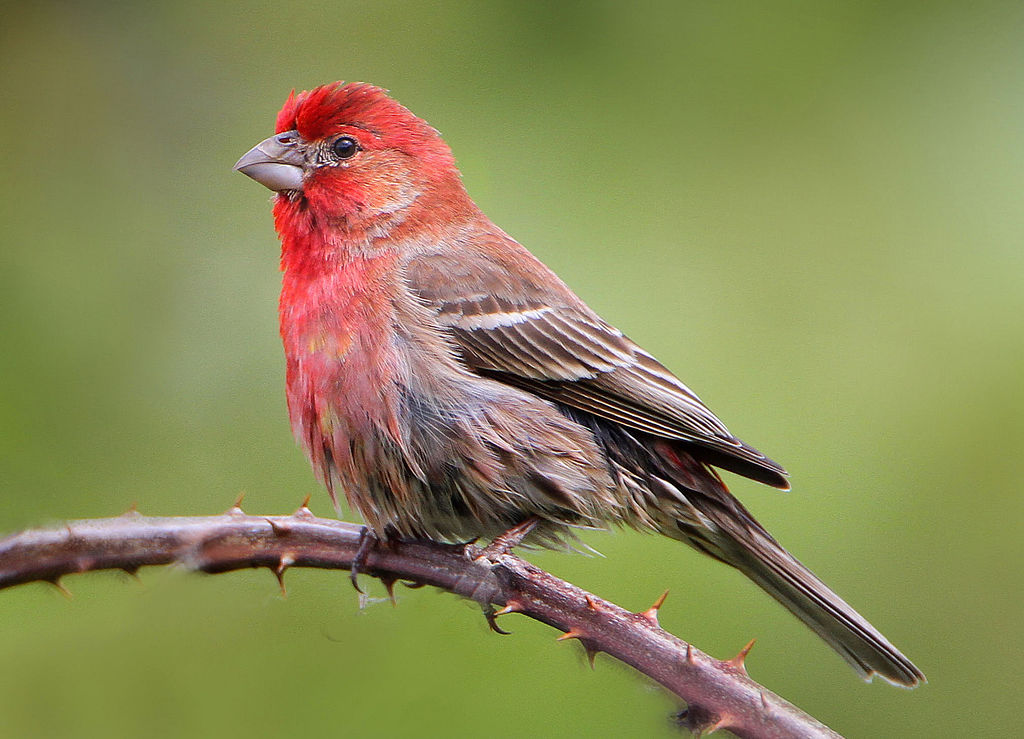
Coloration and Markings: House Finches have gray or brown streaked backs and long, gray wings with black lines and 2 white wingbars on each wing. They have long tails which are gray with white edging and white outer feathers and while the underbelly is white with well-spaced dark streaks as the coloration moves up into the breast the white becomes saturated with rosy hues. These move up into the face to just under the bill and enough to cover the cheeks on the horizontal, though red continues on the forehead and goes to the back of the upper portions of the head. The space in-between is gray, especially in front of the eyes and a grayish-red eyeline goes from the back of the eye to curve around and frame the cheek. These birds have large, short silver bills with a noticeable curve in the upper bill. Females will lack the facial markings of the male and will be brown and gray all over, with tinges of red being present.
Size: These birds measure in at 5.1 – 5.5 inches in length and have wingspans of 7.9 to 9.8 inches.
Habitat: When they aren’t spending time at the forest’s edge or in meadows you will find these birds in farms and cities, foraging for food and not so shy about human habitation nearby.
Diet: White Proso millet, Nyjer thistle, and Black Oil Sunflower seeds are all good choices for making these little Finches happy.
Purple Finch – Haemorhous purpureus
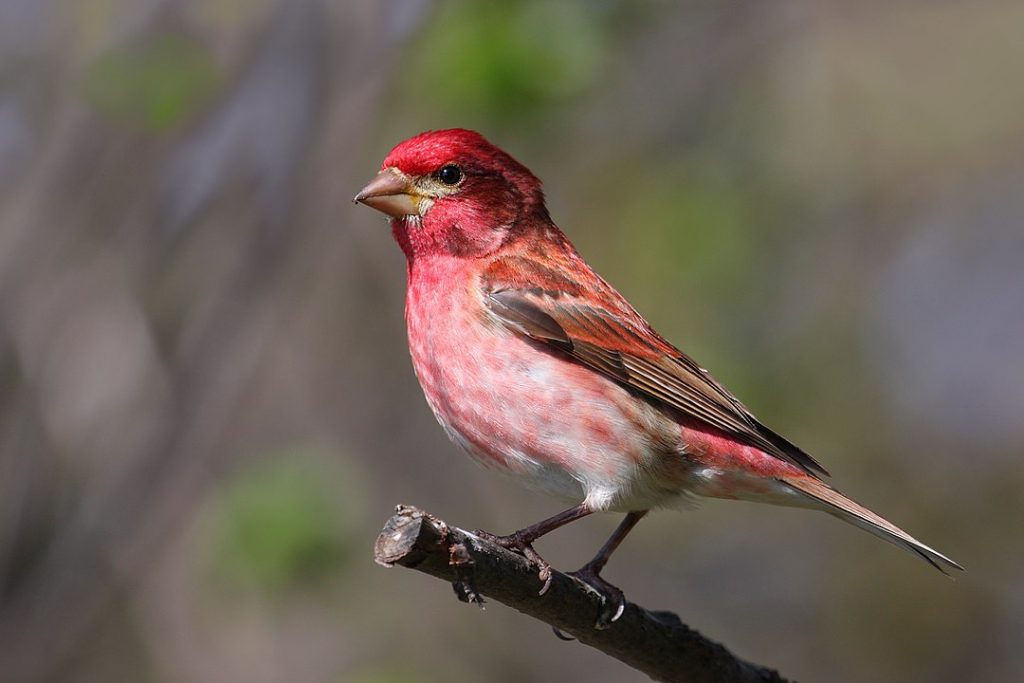
Coloration and Markings: Male Purple Finches look quite handsome in their plumage, with their backs and their long wings being a mix of pinks and browns. They display 2 thin white wingbars on each wing and have short, notched, pink and brown tails. These birds have a white rump but at the underbelly they are white with pinkish-red streaking which thickens into pink-red spots heavy at the breast and solidifies into a raspberry color which takes up most of the face. You may notice darker coloration at the top of the head and in an eyeline which starts behind the eyes and curls around to frame a lighter colored cheek. These birds have strong, conical bills which tend to be black, yellow, or a mix. Females will have no red to them, only a light to olive-brown and heavier streaking, along with a dark line at the throat area and a white eyestripe.
Size: These little purple guys and gals measure in at 4.7 – 6.3 inches in length and haqve wingspans of 8.7 to 10.2 inches.
Habitat: When it is warm these birds prefer coniferous or coniferous and deciduous mixed woods. They can be seen in many places where the vegetation is dense enough to let them feel safe, so you can also look for them in fields, brambles, parks, and backyards.
Diet: Peanuts and Black Oil Sunflower seeds are two favorites and you can always just mix the Sunflower seeds with some chunky peanut butter if you are feeling extra nice. These birds like nectar as well so if you have a flowering garden then that helps and they might try to sample your Hummingbird feeder.
Red-headed Woodpecker – Melanerpes erythrocephalus
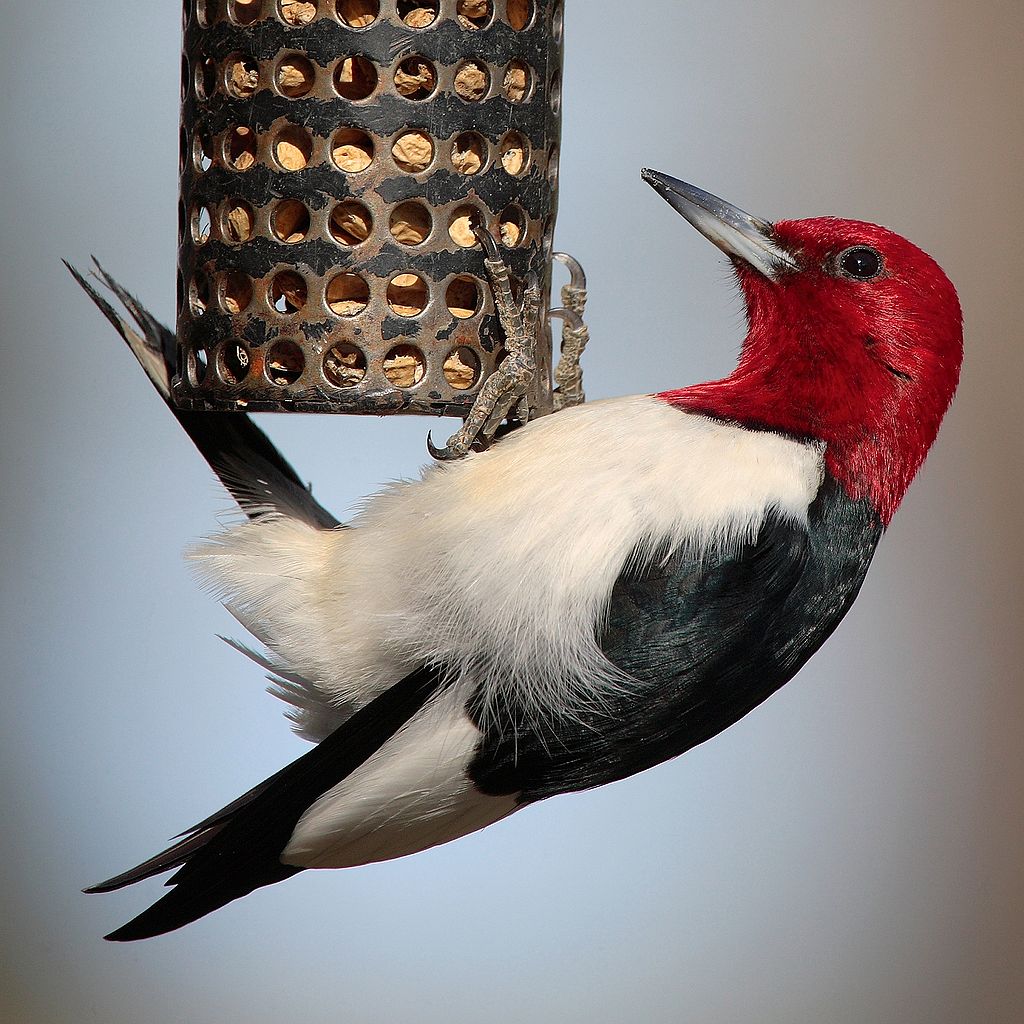
Coloration and Markings: Red-headed Woodpeckers have black backs and long black wings, with large white patches towards the tips. When the bird is at rest this makes it look like the lower back is white but don’t be fooled! These birds also have short, black tails with a snow white rump, underbelly, and breast. Facially, these birds are a brilliant ruby red and this color fills in the entire head and comes down like a bib into the white breast. These birds have long, stout, and straight black bills with a little ivory white closer to the face. Juveniles will have gray and brownish heads and should display a little spotting on the white patches.
Size: These Woodpeckers measure in at 7.5 – 9.1 inches in length and have wingspans of approximately 16.5 inches wide.
Habitat: These birds love Pine forests and wetlands, but they do range out on occasion into parks and backyards.
Diet: Red-headed Woodpeckers like peanuts and suet. You can get their attention sometimes by smearing a little suet on some bark on a tree in your backyard as well. Give it a try sometime and see, these Woodpeckers love it!
Supporting cast (Other Backyard Birds that might pay you a visit)
Our ‘Supporting cast’ birds are a little bonus that we like to throw in for our readers. They are additional birds that you can be on the lookout for at any time of the year and they are beautiful, fascinating, and ready to be spotted. See if you can identify some of these birds this year:
- Northern Cardinal
- European Starling
- Eastern Bluebird
- Red-bellied Woodpecker
- Carolina Wren
Northern Cardinal – Cardinalis cardinalis
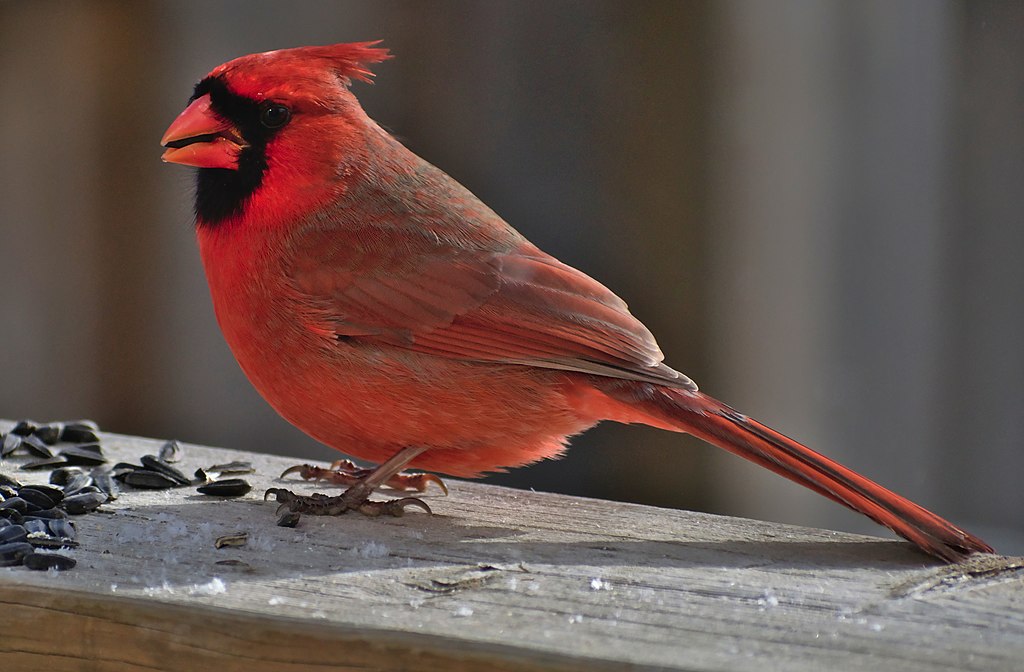
Coloration and Markings: Male Northern Cardinals are quite striking, being completely red all over although you might see a little gray if the bird is molting. They have long red wings and long red tails and their breast and underbelly are indeed red as well. The red colors grows even richer at the face, where you will see the bird’s magnificent red crest and distinctive black mask, which covers the eyes and pulls down sharply under the bill like a small goatee. Finally, you will see a large, orange or red-orange conical bill. Female Cardinals are quite lovely as well but will be a soft brown with reddish tinges throughout their plumage.
Size: These birds measure in at 8.3 – 9.1 inches in length and have wingspans of 9.8 to 12.2 inches.
Habitat: These birds like the forest’s edge when there is some dense vegetation for cover around but they are also no strangers to the city, where you can spot them on phone lines, fences, and stocked-up feeders!
Diet: Suet, chunky peanut butter, and cracked corn are all favorites of the Northern Cardinal and can help you to make a new feathered friend if you leave them out.
European Starling – Sturnus vulgaris
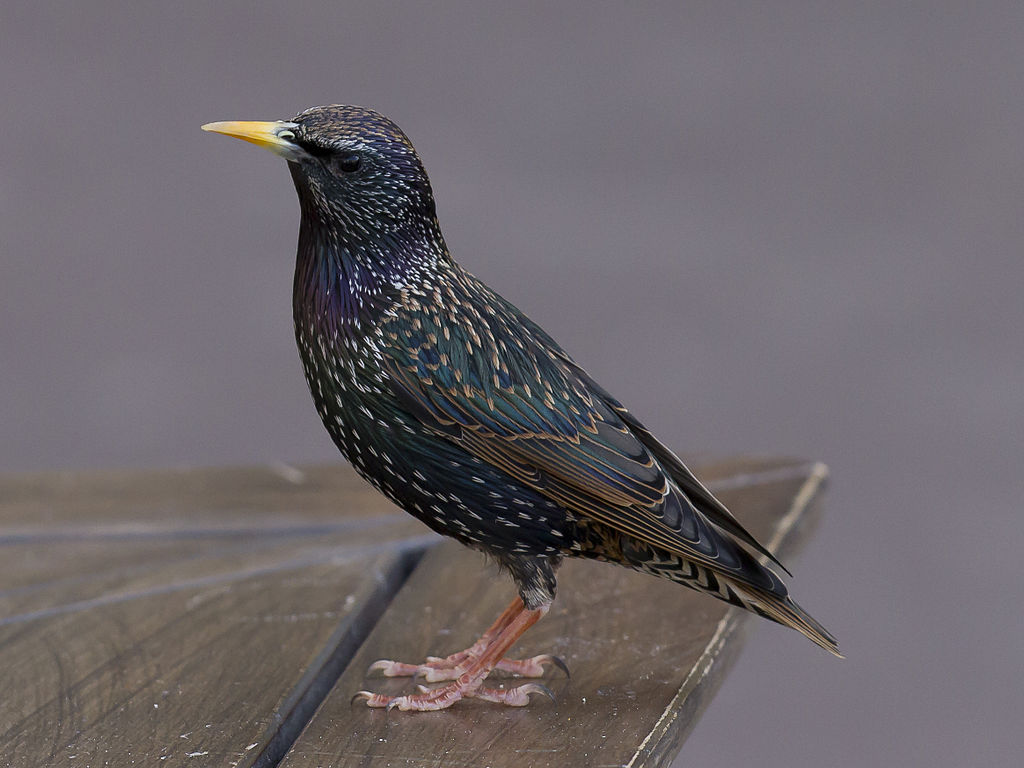
Coloration and Markings: European Starlings are a beautiful, shiny purple-green color that looks like black from a distance. They have long wings and tails and long, straight yellow bills that look quite powerful. In the winter, these birds change things up a bit by adopting brown plumage with white spots.
Size: Roughly Robin-sized, these birds measure in at 7.9 – 9.1 inches and have wingspans of 12.2 to 15.8 inches in width.
Habitat: While you might see European Starlings in trees, these will generally be trees scattered around the city. These birds are quite urbanized and spend their time in farms or town, often perched on phone lines or fences as they look for the next snacks and meals of the day. They are bold birds, so don’t be surprised if you see one walking on the sidewalk. They are quite comfortable around us.
Diet: European Starlings LOVE suet. In fact, it can sometimes be a problem. They tend to spot it and ‘park’ themselves in the feeder until all of the suet is gone. If this becomes a problem for you then you can get Starling-proof feeders so that some of the other birds can have some suet too. Leave out some wheat and oats out to placate the Starlings in the meantime and there shouldn’t be any hard feelings.
Eastern Bluebird – Sialia sialis
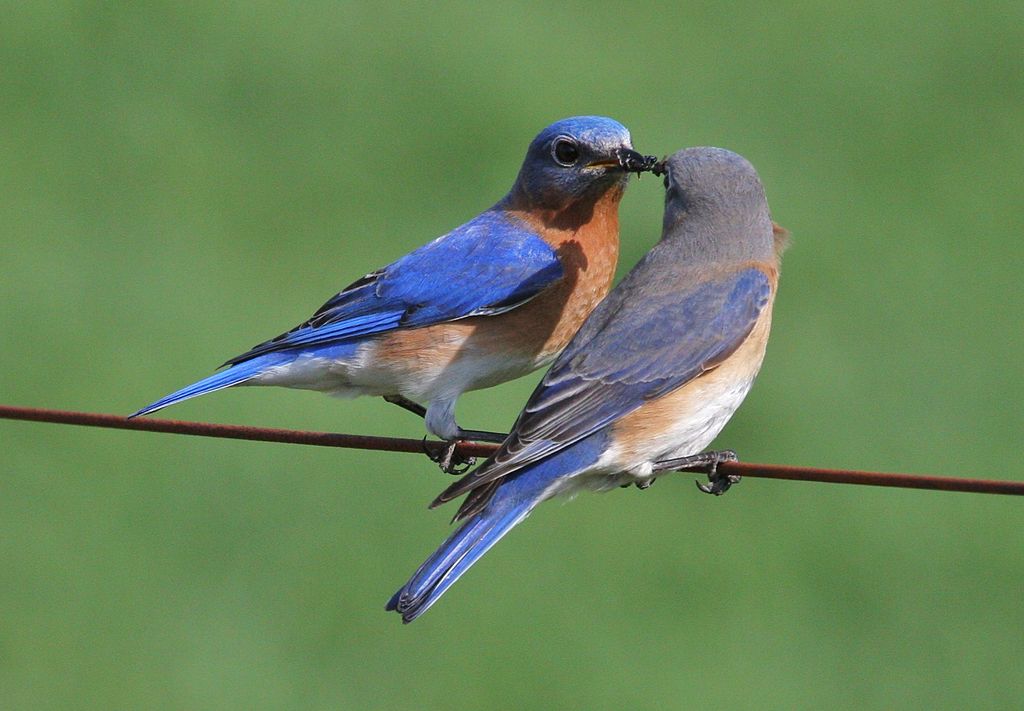
Coloration and Markings: Eastern Bluebirds have blue backs and long, black-tipped, blue wings. They have perky, short blue tails with a little white on the underside coming from the rump. They have white underbellies but as you approach the breast there is a heavy flanking of cinnamon that takes up most of the breast and continues up to the base of the throat before terminating. This cinnamon color also goes from the throat and across the top of the wings horizontally, stoping just short of the back of the neck. Facially, these birds are a lovely blue color and they have medium-length, straight bills with a slight curve to the upper bill.
Size: These birds measure 6.3 – 8.3 inches in length and have wingspans of 9.8 to 12.6 inches.
Habitat: Eastern Bluebirds like meadows and other open areas and are also quite receptive to nest boxes, so if you’d like a new backyard resident then you might consider leaving out a nesting box.
Diet: Suet, Black Oil Sunflower seeds, and dried or live mealworms are all favorites of this bird. You can also leave out some crushed eggshells in the feeder, which these and some other birds will often ingest. This is believed to aid in digestion.
Red-bellied Woodpecker – Melanerpes carolinus

Coloration and Markings: Red-bellied Woodpeckers are beautiful birds. They have zebra-like stripes on their backs and their long wings, which extend down to their medium-length tails. They have a white breast and underbelly, with splashes of red throughout as if someone splashed them with some juice or red Kool-Aid. Facially, they have white faces with some red splashing around the cheeks and lovely red caps which go to the back of their necks. These birds have long, stout, and straight black bills.
Size: These birds measure in on average at 9.4 inches from tip to tail and have wingspans of 13 to 16.5 inches in width.
Habitat: These birds are fond of pine tree forests and hardwoods. They are also frequent visitors to backyard feeders so be sure to leave a little something out for them.
Diet: These birds love suet as well as peanuts, Black Oil Sunflower seeds, grape jelly, and they might even raid the Hummingbird feeder. These guys definitely have a sweet tooth so take advantage and you might just make a new friend!
Carolina Wren – Thryothorus ludovicianus

Coloration and Markings: Carolina Wrens are almost a foxy red-brown color on their backs, short wngs, and long, perky tails. The wings will have a thin wingbar present on each wing and both the wings and tail will be edged with a black and white checkerboard pattern made up of small, blocky dots in the plumage. They have a yellowish-orange underbelly and breast and facially, they have yellow-orange up until under their bill, which sweeps towards the back of the head. Just over this there are scatterings of gray around the cheeks and a large, white eyebrow line just under the red-brown crown. These birds have long, slightly curved silver bills.
Size: These little guys measure in at 4.7 – 5.5 inches in length and have wingspans of approximately 11.4 inches from tip to tip.
Habitat: Carolina Wrens love areas with a lot of trees and brush. Brambles, thickets, shrubs, and thorns… if there is cover and a tree to perch on then you might just spot a Carolina Wren.
Diet: Mix up some crunchy peanut butter with suet cakes and you have a hearty feast that will greatly please the Carolina Wren.
Kansas Bird Buffet
Kansas Wildlife, Parks, and Tourism has some great recommendations when it comes to feeders and attracting specific birds. They even have an informative pdf on the subject and you can get that if you go to their link in our references if you wish to review the full material. For now, we’re going to share some of their recommendations and a few of our own for making the most out of your feeder when it comes to local birds. Try adding some of these items to your feeder to see what happens:
- Suet
- Grape Jelly
- Cracked corn
- Oranges (halved and set in a feeder or nailed to a tree)
- Black Oil Sunflower
Kansas Birding Hot Spots
If you are looking to get out of the house a little then the Chirparazzi recommend a few places that you can go to catch a glimpse or maybe even a photo of some of the Kansas aerial celebs. We’ve got locations around the compass points but if you don’t find something close, just try the reference link we’ve provided and you can surely find something that is just around the corner. So, why not treat yourself? Here are some places to see our favorite feathered friends in the wild:
- Northern hotspot – Blue River Rail Trail
- Eastern hotspot – Lehigh Portland Trails
- Southern hotspot Haysville Hike and Bike Path
- Western hotspot – Talley Trail
- Central hotspot – Jim P. Martinez Sunflower Trail
Detailed descriptions of each location as well as information regarding visiting and what birds you can see at these locations may be found at: https://www.traillink.com/stateactivity/ks-birding-trails/
In Closing
Today we have talked about the popular backyard birds of Kansas and as you can see, there are some real beauties out there just waiting to be spotted by YOU. With 453 species, the ones have listed are just the tip of the iceberg so you’d better get busy. There’s a world of winged wonders out there and they can’t wait to meet you! Until next time, we wish you happy birding and our best!
